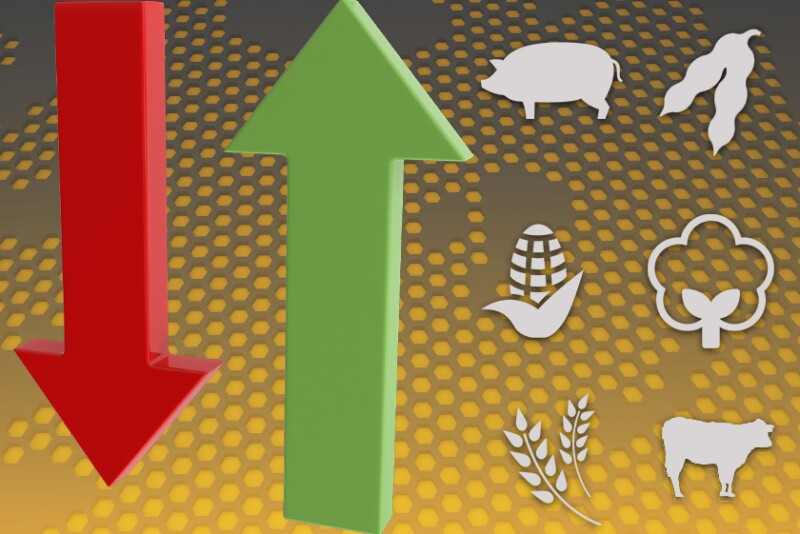GRAIN CALLS
Corn: 4 to 8 cents lower.
Soybeans: 5 to 10 cents lower.
Wheat: 2 to 6 cents lower.
GENERAL COMMENTS:
Corn, soybean and wheat futures are expected to open lower following a three-day holiday weekend, with pressure stemming from rainfall forecast this week for the Northern Plains and much of the Midwest. In other markets, the U.S. dollar index is higher, while Nymex crude oil futures climbed to a 6 1/2-year high at nearly $77 a barrel before retreating to near unchanged.
Most U.S. crop areas were dry over the weekend, but a weak high pressure ridge over western North America should allow some rain to fall in the U.S. Northern Plains, Minnesota, Iowa and southern Canadian Prairies this week, World Weather Inc. said, with Iowa and southeastern South Dakota expected to be among the wettest areas.
Consultant Michael Cordonnier lowered his U.S. corn yield estimate by 2 bu. to 175.5 bu. per acre this week, and his bias is neutral to lower. Incorporating USDA’s June 30 harvested acreage forecast of 84.5 million acres drops his corn crop estimate to 14.82 billion bushels. He says the yield drop stemmed from “ongoing problems in the northwestern Corn Belt – South Dakota, North Dakota, Minnesota, and northwestern Iowa” and said how much lower his yield estimate goes will depend on July weather.
Cordonnier also lowered his Brazilian corn crop estimate another 2 million metric tons (MMT) to 88 MMT and his bias is lower. “The coldest temperatures in 20 years resulted in three consecutive nights last week of freezing temperatures which negatively impacted the safrinha corn in south-central Brazil. The extent of the damage will not be fully known until the corn is harvested, but yields will be very disappointing and there will be poorer quality grain especially for the latest planted corn,” he said.
After last week’s frosts hit Parana and Mato Grosso do Sul particularly hard, the consultancy AgRural cut its production estimate for Brazil’s Center-South from 60 MMT to 54.6 MMT, with the firm saying drought also contributed to the cut.
In weekend demand news, Egypt’s state grain buyer bought 180,000 MT of wheat from Romania in an international tender, as well as 60,000 MT of wheat from Russia. A group of importers in Thailand issued an international tender to buy up to 230,700 MT of animal feed wheat. Jordan tendered to buy 120,000 MT of wheat. Japan is seeking to buy a total of 108,175 MT of food-quality wheat from the U.S., Canada and Australia in a regular tender.
CORN: Weather will remain in focus as the U.S. corn crop nears its critical pollination stage. World Weather projects unsettled weather for most of the Midwest over the next two weeks, which may provide timely moisture for pollination. Traders will look for any signs of improvement in USDA’s weekly crop condition ratings later today. In last week’s report, USDA’s showed U.S. corn rated “good” to “excellent” as of June 27 at 64%.
SOYBEANS: Cordonnier also lowered his U.S. soybean yield projection by 0.8 bu., dropping it to 50 bu. per acre for a crop of 4.33 billion once USDA’s harvested acreage forecast of 86.7 million acres is adopted. He noted that a third of the U.S. soybean crop has been in some level of drought for weeks, with most of those acres located in the northwestern Corn Belt. USDA’s crop condition updates may show some soybean acreage benefitted from recent rains. In last week’s report, 60% of soybean acreage was rated “good” or “excellent” as of June 27.
WHEAT: Welcome rains fell in southwest Alberta, Canada over the weekend, with two more waves of precipitation expected for this spring wheat and canola producing regions. Traders will watch today’s USDA weekly crop condition updates for further deterioration in spring wheat. Last week, USDA reported 20% of the spring wheat crop as “good” to “excellent” as of June 27.
CATTLE: Steady-firm
HOGS: Steady to weaker
CATTLE: Average cattle weights stood at 1,351 lbs. the week ended July 3, which was 4 lbs. lower for the week and 15 lbs. lighter than year-ago. That signals marketings have improved and dryness and heat are taking a toll. Live cattle appear range-bound, with possible pressure from a wholesale beef market that’s dropped to two-month lows. On Friday, live steers averaged $123.82 in five top U.S. cattle markets, down from $125.54 at the end of the previous week. Choice cutout values averaged $285.44, down 6.3% from $304.56 at the end of last week and the lowest since late April. Traders today will look to USDA’s boxed beef market update for an update on July 4 clearance.
HOGS: Hog futures face a weak technical posture after last week’s declines and beliefs the market reached a seasonal top in June. Cash hog bids softened after a firmer start last week, which could result in more sideways action for futures. Friday’s 44-cent dip in the pork cutout value on lackluster movement and a $1.18 drop in average cash hog bids is unlikely to inspire buying. But USDA’s weekly red meat production update showed average hog weights are coming down, though they remain above year-ago levels. Carcasses on daily direct markets Friday averaged $108.21, down 7.4% from $116.89 at the end of last week, according to USDA. Pork cutout values Friday averaged $115.19, up 4.7% from $110.04 at the end of last week. Last week’s slaughter totaled 2.82 million head, down from 2.36 million the previous week.

